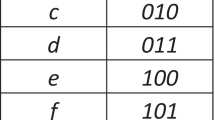Abstract
The author analyzes the disadvantages of the available theories of semantic and linguistic analysis and proposes a formal model that takes into account the semantic–syntactic structure of sentences in natural language. The author provides examples of constructing logical–linguistic models for different types of sentences, based on which the fundamental principles of the synthesis of logical–linguistic models of natural language sentences are formulated.
Similar content being viewed by others
References
“A catalog of linguistic programs and resources on the Internet,” http://www.rvb.ru/soft/catalogue/catalogue.html.
I. R. Gal’perin, Text as an Object of Linguistic Analysis [in Russian], KomKniga, Moscow (2007).
K. A. Filippov, Text Linguistics. A Course of Lectures [in Russian], Izd. S.-Pb. Univ., St. Petersburg (2008).
J. Lyons, Linguistic Semantics, Cambridge Univ. (1995).
V. A. Shirokov, V. M. Bilonozhenko, O. V. Bugakov, et al., Linguistic and Technological Fundamentals of Defining Lexicography [in Ukrainian], Dovira, Kyiv (2010).
E. I. Bol’shakova, E. S. Klyshinskii, D. V. Lande, A. A. Noskov, O. V. Peskova, and E. V. Yagunova, Automatic Natural Language Processing and Computer Linguistics [in Russian], MIEM, Moscow (2011).
A. I. Vavilenkova, “Logical–linguistic model as a way to represent syntactical features of text information,” Matem. Mashiny i Sistemy, No. 2, 134–137 (2010).
D. Jurafsky and Ch. Manning, Natural Language Processing (2012), https://www.coursera.org/course/nlp.
“Support of synonyms in search programs,” http://www-01.ibm.com/support/knowledgecenter/SSEPGG_8.2.0/com.ibm.db2.ii.of.doc/admin/iiysasynsupp.htm?lang=ru.
“Russian Wordnet,” http://wordnet.ru/.
“ABBYY Intelligent Search SDK,” http://www.abbyy.ru/isearch/compreno/.
A. I. Vavilenkova, “A technique of transforming a sentence in a logical–linguistic model,” in: Proc. Intern. Sci.-Tech. Conf. “Computer Systems and Network Technologies,” NAU, Kyiv (2008), pp. 49–53.
L. Tesniére, Elements of Structural Syntax, John Benjamins, Amsterdam (2015).
N. V. Lukashevich, “Cohesion as structural coherence of text” (2011), http://like-money.ru/stati/271-kogeziya-kakstrukturnaya-svyaznost-teksta.
T. H. Cormen, C. E. Leiserson, R. L. Rivest, and C. Stein, Introduction to Algorithms, MIT Press (2009).
E. V. Paducheva, Semantic Studies, Yazyki Slavyanskoi Kul’tury (1996).
Author information
Authors and Affiliations
Corresponding author
Additional information
Translated from Kibernetika i Sistemnyi Analiz, No. 5, September–October, 2015, pp. 176–185.
Rights and permissions
About this article
Cite this article
Vavilenkova, A.I. Basic Principles of the Synthesis of Logical–Linguistic Models. Cybern Syst Anal 51, 826–834 (2015). https://doi.org/10.1007/s10559-015-9776-z
Received:
Published:
Issue Date:
DOI: https://doi.org/10.1007/s10559-015-9776-z




